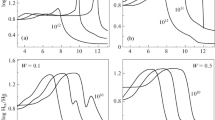Abstract
THE Balmer, Paschen and Brackett lines of hydrogen in the solar spectrum are much wider than they should be according to computations based on the classical widening mechanism of the hydrogen lines1—the statistical Stark effect of the ions surrounding the emitting atoms. The amount of widening is greater for the Pasohen than for the Balmer lines; it is greatest for the Brackett lines. It seems impossible to ascribe this widening to atomic processes, since Jürgens2 has shown in elegant laboratory experiments that the profile of H β is explained by the statistical Stark effect of the ions. Hence, the abnormal widening of the hydrogen lines must be explained by a mechanism which is active in the solar photosphere but not in laboratory experiments. It is difficult to ascribe it to super-excitation since the wings of the hydrogen lines are formed in rather deep parts of the solar photosphere, where deviations from thermodynamical equilibrium are not very likely to occur. It can be shown that the widening is probably explained by the microturbulence of the solar photosphere, a mechanism suggested to me by Prof. A. Unsöld, of Kiel.
Similar content being viewed by others
References
Jager, C. de, Recherches Observ. Utrecht, 13, No. 1 (1952).
Z. Phys., 134, 21 (1952).
Author information
Authors and Affiliations
Rights and permissions
About this article
Cite this article
JAGER, C. High-energy Microturbulence in the Solar Photosphere. Nature 173, 680–681 (1954). https://doi.org/10.1038/173680b0
Issue Date:
DOI: https://doi.org/10.1038/173680b0
- Springer Nature Limited
This article is cited by
-
Inhomogeneous model of the photosphere
Solar Physics (1975)
-
Zur Deutung der Rotverschiebung im Sonnenspektrum
Die Naturwissenschaften (1955)





